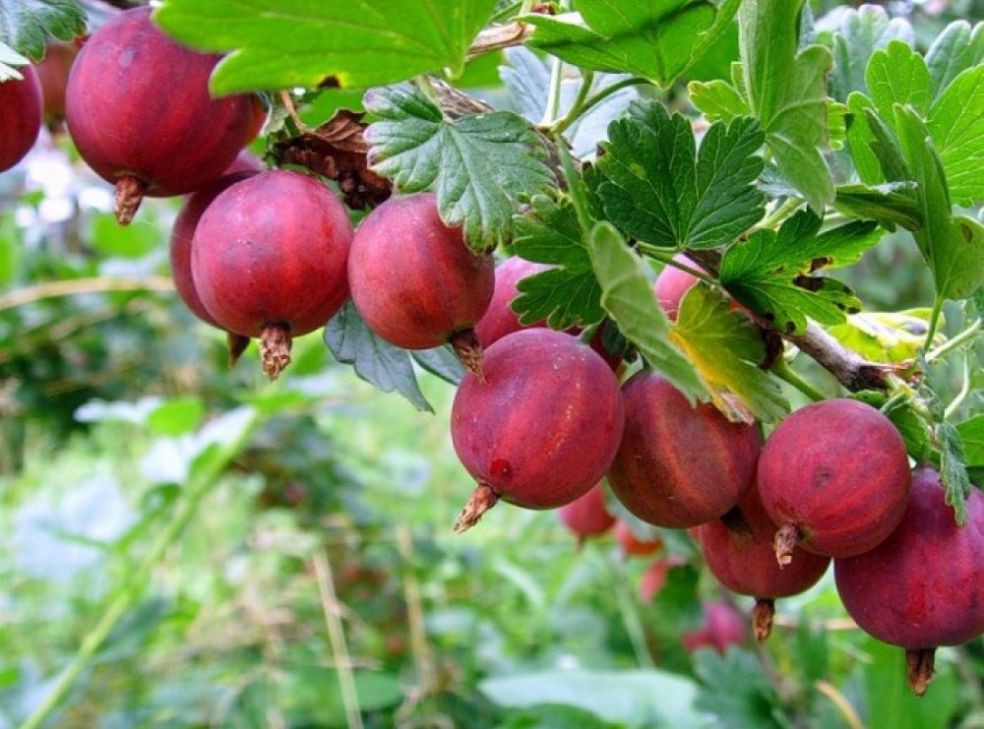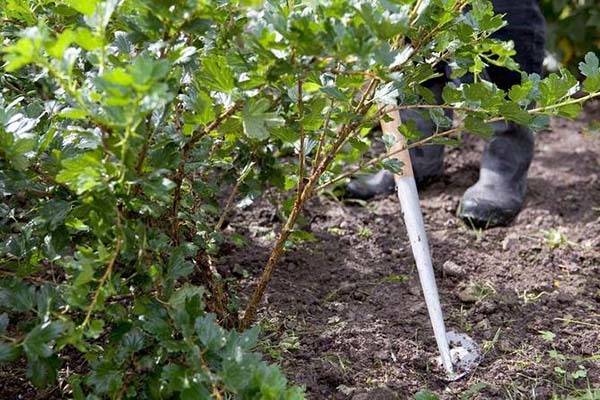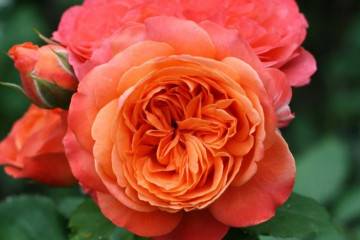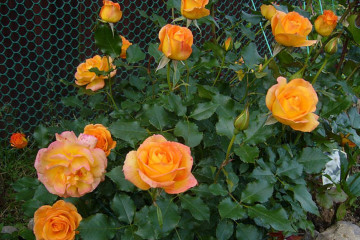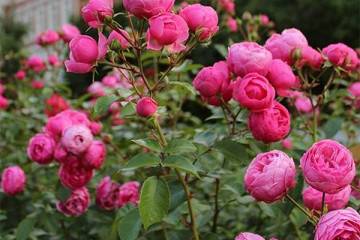Gooseberry Kolobok - the secrets of growing a bush
Content:
Gooseberry berries are a storehouse of vitamins (C, P, group B), minerals (zinc, copper, potassium, calcium, iron, iodine), folic acid, pectins, ascorbic and citric acids, valuable for humans. The Kolobok variety deserves special attention of gardeners due to its excellent taste, high yield and disease resistance.
Creation history and description
Gooseberry Kolobok is a hybrid variety obtained in 1977 as a result of crossing of two varieties Pink 2 and Smena. It was bred by the breeder I. Popova in order to inherit the best qualities of the parental species: a small number of thorns, resistance to powdery mildew and large-fruited. These properties made Kolobok popular in the central, southern and even northern regions of the post-Soviet space.
Bush characteristic
This sprawling plant grows up to 1.5 meters in height. The branches are tall, powerful, flexible, with a small number of thorns. The shoots have large leaves on short petioles. They have a rich green color with expressive veins.
Fruit characteristics
Kolobok berries begin to form in April-May, and at the end of June-July, you can harvest the finished crop.
The appearance of the fruit is remarkable:
- dense skin has a deep red color, covered with a waxy coating;
- berries are large, round, weighing 4-8 grams each;
- the pulp is tender, juicy, slightly crunchy;
- inside each berry there are up to 15 small seeds.
Varietal features
The gingerbread man has characteristic features that distinguish it from other varieties of gooseberries.
Fruiting
Flowering occurs at the end of April. Within 2-2.5 months, large ripe berries form in place of light green flowers. Harvesting takes place in the middle of summer.
With proper agronomy, the bush begins to bear fruit for 2-3 years of growth. It is mid-season, high-yielding. Under favorable growing conditions, up to 10 kg of ripe gooseberries can be harvested from one bush per season. The fruits are easily removed from the branch.
Refers to table types. In terms of organoleptic properties, the berries received 4.5 points out of a possible 5. They are distinguished by a sweet taste with a slight acidity and a pronounced fruity aroma. Contain, in addition to fiber, sugar, pectins, ascorbic acid.
The skin of the fruit is dense, does not crack when pressed, so the gooseberry is well adapted for transportation.
Frost and drought resistant
Has excellent frost resistance. It tolerates low air temperatures and frosts down to -20 ° C. In areas with harsh long winters, gooseberry bushes are covered with agrotechnical fiber, burlap, spruce branches.
Sensitive to sudden changes in temperature. Therefore, in areas with unstable cold weather, Kolobok is additionally protected with covering materials.
Gooseberries require regular watering. Calmly tolerates short-term drought.Prolonged lack of moisture leads to a decrease in the number and size of berries, their shedding.
Disease and pest resistance
A healthy plant has good immunity against diseases and pests. Therefore, the Kolobok does not create any special problems for the gardener.
Violation of cultivation technology, lack of nutrients, waterlogging of the soil lead to damage by fungal diseases (white spot, goblet rust) and insects (caterpillars, aphids). I treat diseased plants with fungicides and special preparations.
Using berries
Gingerbread man is grown for personal needs, industrial production of jams, compotes and for sale. Berries picked at the stage of technical ripeness are perfectly preserved and transported.
Advantages and disadvantages of gooseberry
The popularity of Kolobok among gardeners is due to the following advantages:
- frost and drought resistance;
- fast and abundant fruiting;
- good taste, transportability;
- ease of harvesting due to the small number of thorns;
- resistance to diseases and pests.
The disadvantages are minor, but they are:
- the need to thin out the bushes due to the tendency to thicken;
- splendor and spreading;
- sensitivity to sudden changes in temperature.
Planting young seedlings
Planting agrus in the ground has a certain order and consists of preparatory and main stages.
Selection and preparation of bushes
One-year-old or biennial plants are considered the best. Particular attention is paid to the external examination of the bush. It should have 3-4 strong healthy shoots. The gooseberry root system should have well-developed lateral processes.
In order for the fibrous roots of the gooseberry to develop well in the soil, the largest of them are pinched at the ends immediately before planting. This allows the plant to develop a dense network of lateral processes.
Time and seating scheme
The optimal time for planting young bushes is autumn. A warm day is selected 3-4 weeks before the start of frost. During this time, the young plant will take root and prepare for winter.
The gingerbread man is also planted in the spring. At the same time, it is important not to miss the moment before bud break.
To get the maximum yield from each bush, they are planted at a distance of 1.5 meters from each other, leaving a row spacing of at least 2 meters for convenient weeding, feeding and hilling. At the same time, the Kolobok receives enough light, but the garden bed occupies a large area.
For those gardeners who do not have a large plot of land, but want to get a large harvest in a small area, you can reduce the row spacing to 1.2 meters and the distance to honey with bushes to 1 meter.
Seat selection
A place for gooseberries is prepared in advance, taking into account the following features:
- the soil should be neutral or slightly acidic;
- sandy, sandy loam, loamy soils are suitable;
- grows well in sunny areas;
- grows poorly in lowlands, in moist soils and with a high occurrence of groundwater;
- does not like drafts and strong winds;
- grows poorly in areas that previously had raspberries or currants.
Site preparation
The place is cleared, weeds, excess shrubs are removed, and dug up if necessary.
The planting hole for the gooseberry should be 2 times wider and deeper than its root system. A bucket of a mixture of humus with 200 grams of wood ash and 100 grams of complex mineral fertilizer is poured into the bottom of the pit.
Planting process
Planting gooseberries is a simple process, if you do all the work in order:
- 5-7 liters of water are drunk at the bottom of the pit.
- A gooseberry seedling is dipped into it and the roots are carefully straightened.
- A slightly inclined bush is carefully sprinkled with earth so that the root collar is at a depth of 5-7 centimeters from the surface of the earth.
- The earth is tamped around to make a hole for watering and feeding a young plant.
- A bucket of water is poured under the bush, the earth is mulched.
Care features
Like any garden plant, the Gingerbread Man requires careful maintenance, which involves watering, weeding, mulching, pruning and preparing for winter.
Watering
Watering frequency depends on weather conditions. In case of rare rains, the regularity of watering once a week up to 30 liters under the bush should be observed, especially during the period of flowering, active growth of shoots and ripening of fruits. The plant tolerates a short-term lack of moisture safely. Waterlogged soil under the bush leads to plant decay. In October, pre-winter watering will take place - 40 liters of water under the bush.
Weeding
Frequency - once every 2-3 weeks with the removal of weeds. In order not to damage the underground part of the plant, loosening is carried out carefully.
Top dressing and mulching
Fertilizers are applied in the spring for 3-4 years of gooseberry development. To do this, mix and pour under the bush:
- 5-6 kg of compost;
- 20 grams of ammonium sulfate and potassium sulfate;
- 50 grams of superphosphate
Watered with water, mulched with peat, rotted manure, straw.
Garter and trim
The gingerbread man is distinguished by high spreading bushes and good fruiting. Under the weight of the berries, some shoots sink to the ground. This causes rotting and spoilage of the crop. To support the bush, metal, wooden, plastic supports are used.
It is carried out in the fall in several stages:
- In the 1st year of growth, 2-3 buds are left on each shoot.
- On the 2nd, branches 20 cm long and inclined to the ground are removed.
- On the 3rd, they are thinned out, removing excess lateral branches.
- Subsequent years - thin out, cut off dry branches, 6-7-year-old shoots and inclined to the ground.
Preparation for wintering
Before the onset of cold weather, the branches are collected neatly together using a rope or wire. The land around the bushes is watered, dug up and mulched. The bush is wrapped with agrofibre, burlap.
Reproduction
The best time of the year for seating Kolobok is autumn. To get young shoots, gardeners use vegetative propagation methods:
- Cuttings - annual shoots are cut, divided into cuttings 10 cm long, dipped into a growth stimulator, and then into the nutrient substrate of the greenhouse at an angle of 45 °.
- Dividing the bush - dig up the mother bush, separate 2-3 lateral shoots with roots and plant it separately.
- Layers - a powerful lateral shoot is buried in earth, by the fall it starts up roots, and it is planted.
Gingerbread man is an excellent table gooseberry with good yield, flavor and disease resistance. It is suitable for consumption both fresh and for preparations for the winter.
